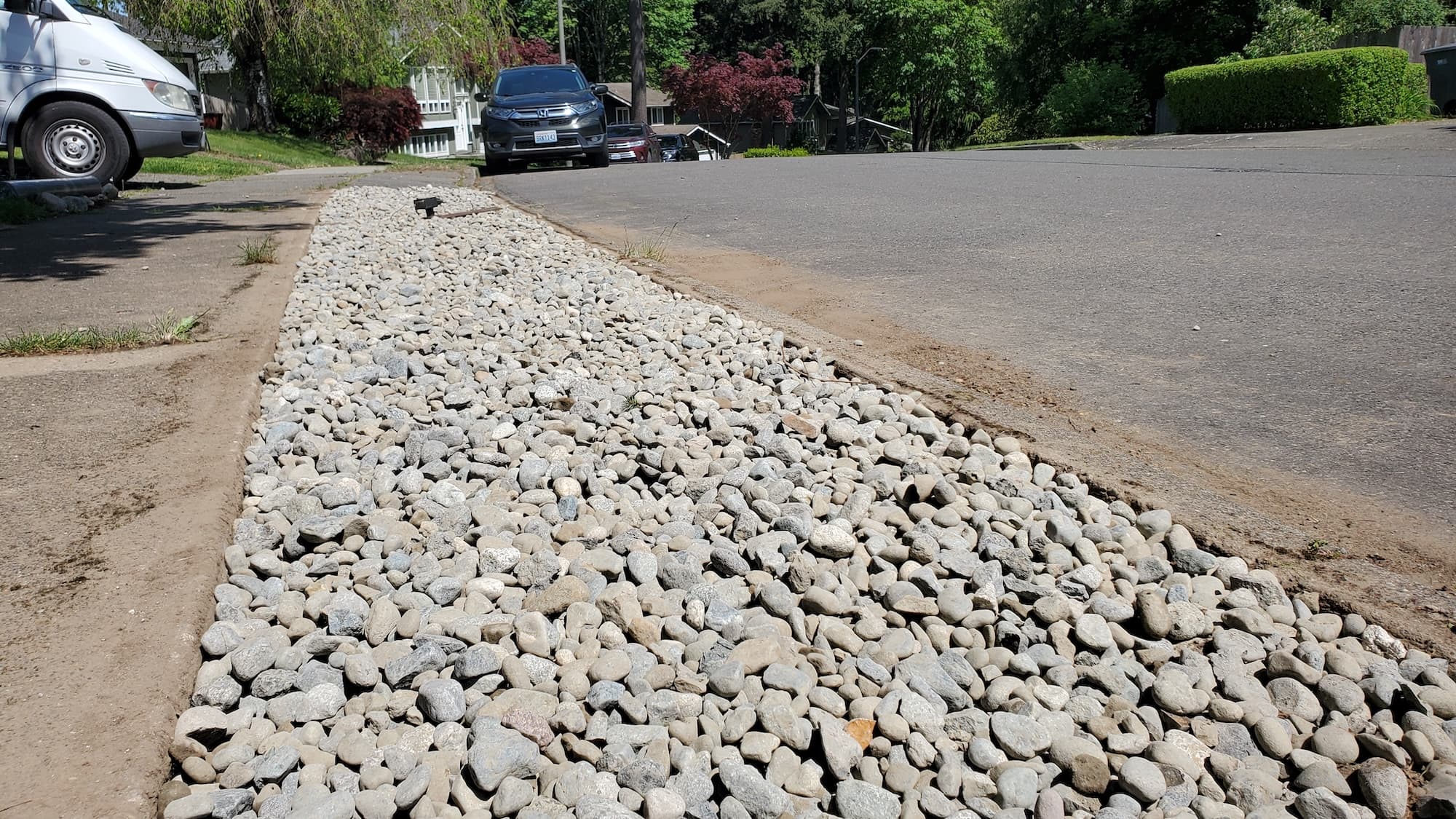West Seattle Lava Rock Gravel Installation
Homeowner’s Issue
West Seattle yards suffer from a handful of repeat problems: heavy winter rain, pockets of compacted fill or glacial till, steep runoffs toward Puget Sound, and shady, moss‑prone corners near Schmitz Preserve. Many homes on the Admiral and Alki slopes have thin topsoil over dense subsoils, so plants that do well uphill struggle in the flatter, wetter beds. Rain from October through April floods shallow beds, churns mulch into muddy patches, and drives weeds into disturbed areas. Summer brings a short dry window—July and August—where new installations establish best.
HOAs and neighbor lines on tighter lots mean edging and neat finishes matter; a loose gravel border looks sloppy fast if not contained. Sun exposure varies block‑to‑block: West‑facing terraces get late sun, while north slopes stay damp and shaded, promoting moss and ivy. Local weed pressure is constant—bindweed, ivy, and grass runners—so we avoid herbicides and rely on physical removal and long‑lasting barriers. West Seattle homeowners want something that drains, looks tidy from the street, and survives winter with minimal fuss. Lava rock gravel is a sustainable option for those needs, stabilizing surfaces, improving runoff, and cutting repeat maintenance on the wettest microclimates in our neighborhoods.
Our Quality Service
We install lava rock gravel using tried‑and‑true methods tailored to West Seattle lots. We start with a site assessment, hand‑pull weeds, and regrade where needed. For access‑challenged plots we bring mini‑skids and wheelbarrows; for flatter yards we use plate compactors to set a firm base. We use geotextile fabric, edge restraint, and 1–3” depth placement depending on use.
Timeline: most small front‑yard installs finish in a day; medium jobs (driveways, larger beds) take 1–3 days. We work in the dry window when possible for best compaction and settling. Everything is done without chemical herbicides—only mechanical and organic controls.
Benefits: better drainage, less mud through your house, improved curb appeal for Admiral/Alki streets, and a durable surface that cuts season‑to‑season maintenance.
What’s Included
- Onsite assessment and material estimate.
- Hand removal of surface weeds and light debris.
- Light grading and compaction of the base.
- Geotextile fabric installation for long‑term separation.
- Even distribution of lava rock gravel to agreed depth.
- Edge restraint (metal or timber) for containment.
- Site cleanup and haul‑away of green waste (see options).
Options / Upgrades:
- Mulch + fabric alternative for planted areas.
- Organic weed control program (mechanical & natural products).
- Additional decorative stones or boulders for focal points.
- Haul‑away vs. green‑bin drop‑off for removed material.
- Permeable edging or driveway transition installation.
Before & After / Expectations
Expect some noise during work (mini‑skid, compactors) and a day or two of disruption for most yards. Access matters—tight sidings or stairs add time. We separate green waste from rock and recycle what we can; larger volumes are hauled away per your choice.
After installation the surface will settle over 1–2 months; we return for a light top‑up if needed within the agreed period. Maintenance is minimal: comb or rake leaves out, remove invasive runners as you see them, and top up thin spots in late summer during the dry window. In shady corners expect more moss/ivy pressure—plan for occasional hand‑weeding or targeted organic control.
FAQs
Q: How long will the lava rock last?
A: Indefinitely as a surface—rocks don’t decompose. Expect some settling; a seasonal top‑up may be useful after the first winter.Q: Do you use herbicides?
A: No. We rely on hand removal, fabric barriers, and organic options only.Q: Can lava rock be used on slopes?
A: Yes, with proper edge restraint and sometimes a coarse base or grid to lock material on steeper pitches.Q: How soon can plants be added?
A: Plant in pockets at installation or wait until after settling; summer planting during the dry window helps roots establish.Q: Will this affect drainage to the street or neighbor?
A: Proper grading and permeable fabric reduce runoff; we address high‑flow paths and use diversion where needed.
Call to Action
If you’re in West Seattle and tired of mud, moss, or messy beds, book a free estimate. We schedule fast, work clean, and know the quirks of Alki, Admiral, and nearby blocks. Email neatandtidyseattle@gmail.com or call/text 206‑538‑9344 to get a photo estimate or set a site visit. Free estimates, practical advice, and honest timelines — we’ll show up and do it right.










